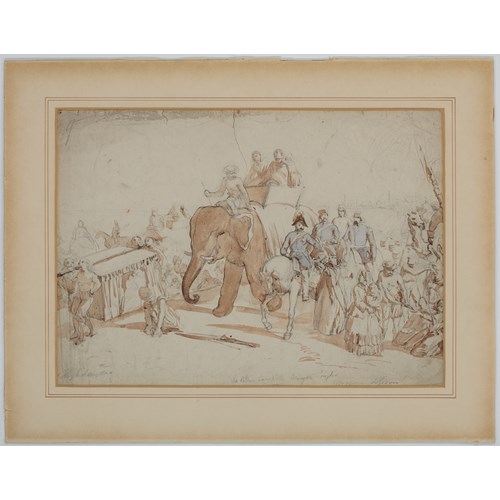Marketplace
A Study of a Red-Tailed Shrike (Lanius phoenicuroides)
A Study of a Red-Tailed Shrike (Lanius phoenicuroides)
Date c. 1820–1860
Period 19th century
Origin China
Medium Watercolour and bodycolour heightened with gum arabic
Dimension 31 x 31 cm (12¹/₄ x 12¹/₄ inches)
Made for the European market
Stock No.: A5293
With a keenly poised eye, sharp beak and projecting breast, this astute bird appears moments away from swooping upon its unsuspecting prey. Above the white underside, rufus feathers descend from the crown to the tip of the tail, contrasting against a velvety black eyestripe and primaries. A dash of yellow marks the formidable point of the beak. The bird perches on a giant thorny species of clumping bamboo (Bambusa arundinacea), which is native to China, India and Pakistan.
The red-tailed or Turkestan shrike occupies shrubby and open countryside in Central Asia. Frequently shrewd hunters, they are known to impale their prey, such as insects, on the thorny spines of bushes. These caches attract the females, as do snail shells and colourful objects acquired by the males to adorn their territory.
This highly accomplished study of both flora and fauna adheres to the classical Chinese tradition of bird and branch paintings typified by finely balanced compositions and detailed observation. Chinese artists also illustrated plants with browning foliage and pale green undersides to the leaves, as instructed in traditional painterly texts. The astoundingly minute brushstrokes delineating the patterns on individual tail feathers and highly subtle tonal gradations around the bird’s cheek attest to the mature conviction of a truly experienced hand.
This work would likely have formed part of an album of scientific studies for a western patron, keen to discover the natural wonders of distant lands.
Bibliography:
Craig Clunas, 1984. Chinese Export Watercolours. London, Victoria & Albert Museum.
Judith Magee, 2013. Chinese Art and the Reeves Collection, Natural History Museum, London.
Kai Wang, 1992. The Mustard Seed Garden Manual of Painting, Princeton University Press.
Kate Bailey, 2010. “The Reeves Collection of Chinese Botanical Drawings”. The Plantsman n.s. 9(4): 218–225.
Rosalien van der Poel, 2016. Made for Trade Made for China, Chinese Export Paintings in Dutch Collections. Leiden University.
Stock No.: A5293
With a keenly poised eye, sharp beak and projecting breast, this astute bird appears moments away from swooping upon its unsuspecting prey. Above the white underside, rufus feathers descend from the crown to the tip of the tail, contrasting against a velvety black eyestripe and primaries. A dash of yellow marks the formidable point of the beak. The bird perches on a giant thorny species of clumping bamboo (Bambusa arundinacea), which is native to China, India and Pakistan.
The red-tailed or Turkestan shrike occupies shrubby and open countryside in Central Asia. Frequently shrewd hunters, they are known to impale their prey, such as insects, on the thorny spines of bushes. These caches attract the females, as do snail shells and colourful objects acquired by the males to adorn their territory.
This highly accomplished study of both flora and fauna adheres to the classical Chinese tradition of bird and branch paintings typified by finely balanced compositions and detailed observation. Chinese artists also illustrated plants with browning foliage and pale green undersides to the leaves, as instructed in traditional painterly texts. The astoundingly minute brushstrokes delineating the patterns on individual tail feathers and highly subtle tonal gradations around the bird’s cheek attest to the mature conviction of a truly experienced hand.
This work would likely have formed part of an album of scientific studies for a western patron, keen to discover the natural wonders of distant lands.
Bibliography:
Craig Clunas, 1984. Chinese Export Watercolours. London, Victoria & Albert Museum.
Judith Magee, 2013. Chinese Art and the Reeves Collection, Natural History Museum, London.
Kai Wang, 1992. The Mustard Seed Garden Manual of Painting, Princeton University Press.
Kate Bailey, 2010. “The Reeves Collection of Chinese Botanical Drawings”. The Plantsman n.s. 9(4): 218–225.
Rosalien van der Poel, 2016. Made for Trade Made for China, Chinese Export Paintings in Dutch Collections. Leiden University.
Date: c. 1820–1860
Period: 19th century
Origin: China
Medium: Watercolour and bodycolour heightened with gum arabic
Dimension: 31 x 31 cm (12¹/₄ x 12¹/₄ inches)
More artworks from the Gallery


_T637876960859116933.jpg?width=2000&height=2000&mode=max&scale=both&qlt=90)




_T638446318994385662.jpg?width=500&height=500&mode=pad&scale=both&qlt=90&format=jpg)

